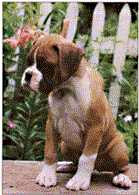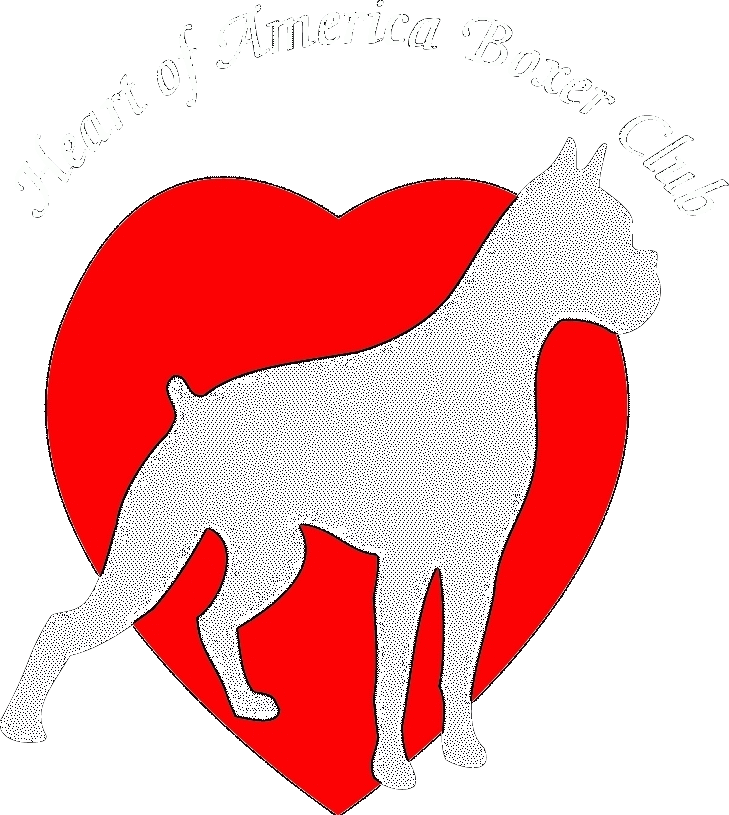 Meet the Boxer
Meet the Boxer
A Unique Breed, the Boxer wants to meet you, your children, and every other member of your family !!
The Boxer's most notable characteristic is his desire for human affection. Through his spirited bearing, square jaw, and cleanly muscled body suggest the well-conditioned middleweight athlete of dogdom, the Boxer is happiest when he is with people--especially children. His short smooth coat, handsome chiselled head, and striking silhouette never fail to excite comments from passersby as he trots jauntily by your side with neck arched and tail held erect. Yet the Boxer's greatest wish is to be with children, watching protectively over their play. He is truly a "dog for all seasons," suiting the need for household guardian, attractive companion, and children's playmate and loyal friend.
Origin: The Hunter
The Boxer's historical background begins in feudal Germany. Here, a small, courageous hunting dog with mastiff-type head and undershot bite was used to secure a tenacious hold on bull, boar, or bear--- pending the hunter's arrival. He became a utility dog for peasants and shop owners. His easy trainability even found him performing in the circus. In the 1880s, descendants of this type of dog were bred to a taller, more elegant English import, and the era of the modern Boxer had begun. Imported to America after the first World War, his popularity really began in the late 1930s. His appeal in the show ring led to four "Best in Show" awards at prestigious Westminster Kennel Club between 1947 and 1970.
Physical Appearance
A few specifics. The Boxer is a medium-sized dog ranging from 21 inches high at the shoulder in a smaller female up to 25 inches (sometimes even taller) in a large male. Adult weight may reach 65-80 pounds in the male, with females about 15 pounds less. There are no miniature or giant varieties. The short, close-lying coat is found in two equally acceptable and attractive basic colors-fawn and brindle. The fawn may vary from a tawny tan to an especially beautiful stag red. The brindle ranges from sparse, but clearly defined black stripes on a fawn background, to such a heavy concentration of black striping that the essential fawn background color barely, although clearly, shows through (which may create the appearance of "reverse brindling").
White markings should be of such distribution as to enhance the dog's appearance, but may not exceed one-third of the entire coat. It is not uncommon to have a totally white Boxer born in a litter. An all-white coat, or a predominantly white background (known as a "check") may occur. In order to retain the beauty of the true fawn and brindle colors, American Boxer Club members are pledged not to register, sell, or use these "whites" for breeding.
Breed Characteristics: "Beauty and Brains"
The Boxer's official classification in the "Working Group" of dogs is a natural. His keenest sense, that of hearing, is enhanced by the cropped, erect ears and makes him an instinctive guard dog, always alert. He has also been used as a courier during war time, and as a seeing-eye dog for the blind. Although always vigilant, the Boxer is not a nervous breed, and will not bark without cause. He has judgment, and an uncanny sense of distinguishing between friend and intruder. One of the delightful qualities that sets the Boxer apart is the unique mobility of his expressive face. The skin furrowing of the forehead, the dark, "soulful" eyes, and at times almost human attempts to "converse," make his replacement by another breed difficult for one who has owned a Boxer. He mimics the mood of his master and can spend hours quietly lying at his feet.
Buying Your Puppy
From the Breeder
The conscientious breeder plans a breeding to reproduce the best characteristics of an outstanding sire or dam. His guide is the official AKC Standard of the breed---the written "blueprint" that helps keep the breed uniform for generations to come. The more common disappointments for pet purchasers come from commercial sources---especially pet shops that often buy puppies from the infamous "pup mills" that take little notice of the quality or health they are producing. The reputable breeder, on the other hand, will not only be able to demonstrate the pedigree and registration papers, but will also show you either the sire or dam themselves, or pictures of the parent who may be owned elsewhere. Though the mere presence of "papers" does not guarantee good health, conformation, or temperament, you will most often find these attributes in the puppy who has been raised with loving care in the home or kennel of a conscientious breeder.
The serious breeder often strives to produce a potential "champion" or show prospects. Since not all of the litter can quite reach this goal, the breeder will able to offer you a good-looking brother or sister of the show prospect at a reasonable price. Sometimes the distribution of white markings alone (often referred to as "flash") may make the difference between the so-called "pet" and show-potential puppy. The pet puppy will have benefited from the same proven bloodlines, nutrition, and medical care as its "champion" littermate. Here is your best buy.
See also the section at this site on "Buying a Boxer puppy?"
Care of your Boxer
Should he be confined?
The Boxer requires relatively little care, but ownership of any dog is a definite responsibility. Your Boxer should not be allowed to run loose. Exercise within a fenced area or on a leash should be adequate. It also prevents a potentially unpleasant encounter with a neighbor's dog or an overly effusive greeting that may frighten the small child who may not have had the chance to know how instinctively tolerant the Boxer really is. Death from automobiles, poison, or a myriad of other causes may await the Boxer who run loose in the neighborhood. Remember, too, that improperly protected screen doors are a common mode of unexpected house exit.
What about a crate?
A crate is an invaluable asset to your puppy's training and well-being. It is not a prison. A crate is a safe haven for the puppy when his owners go to work or the grocery store, a place where his owners don't have to worry about his chewing of electrical cords or furniture. Since a puppy is loathe to soil his crate, it is a great aid in housetraining. If you leave the crate door open, you will find that the puppy will probably enter the crate voluntarily when he wants to rest or retreat. Be sure to put the crate in a warm place. The Boxer is sensitive to temperature extremes and does not enjoy drafts, summer heat, or cold. He should definitely not be kept outdoors.
How Much Grooming?
The Boxer requires very little, and it can easily be done by the owner. Nails must be trimmed regularly unless naturally worn down on a hard surface. An occasional currycombing and/or bath should suffice---the Boxer has a natural tendency to keep himself clean. Tartar may have to be removed from the teeth periodically, especially as the Boxer grows older. You can learn to do this yourself, or use the services of your veterinarian.
What About Obedience Training?
Many Boxers are great successes in the obedience ring. However, that same innate intelligence that makes him quick to learn also gives the Boxer a mind of his own. The trainer must be purposeful and patient. The puppy should be at least six months old before any serious work is begun. The well-trained Boxer is a glorious picture going through his paces in the obedience ring, such trials usually being held in conjunction with most dog shows.
Staying in Touch
It is very advisable to maintain a relationship with your puppy's breeder. The breeder can be an invaluable ally to you throughout your Boxer's life, and can advise you about care and health matters that are unique to the breed.
Bringing a puppy or even an older dog into your home and your life is a major decision. It brings with it responsibility and commitment, but it also renders supreme joy, laughter, and sadly, but inevitably, tears. No one of us who has ever shared his life with a Boxer would have it any other way.
The American Boxer Club
A member of the American Kennel Club, the American Boxer Club is the parent organization of over fifty clubs throughout the United States. Individuals belonging to these clubs are dedicated to preserving the desirable qualities of the Boxer as set forth in the breed Standard. Your local club may be found through this Website or by contacting the secretary of the American Boxer Club whose name and address may also be found at this Website.

